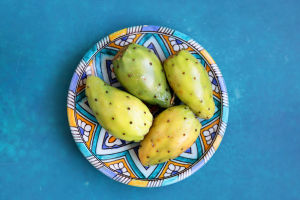Have you ever encountered a cactus fruit? Known as the "cactus pear" or "prickly pear," this fruit is not only delicious but also packed with nutrients.
Grown primarily in dry, warm environments like Mexico, the Mediterranean, and parts of Africa and the Middle East, the cactus fruit has made its way to various corners of the world. Let’s explore the fascinating world of cactus fruit together, a unique superfood with endless possibilities.
What Does Cactus Fruit Look Like?
The cactus fruit has a distinct, vibrant appearance. The fruit, which is about the size of a plum, has a thick, spiky skin that can range in color from green to a deep reddish-pink. Its flesh is typically bright pink or red, and inside, you'll find small black seeds that are easily edible. While the outer skin is tough and covered with small spines, it can be peeled away to reveal the juicy, flavorful pulp inside.
How to Enjoy Cactus Fruit
Eating cactus fruit is an experience in itself. Once you remove the skin, you’ll be left with a sweet, refreshing pulp. The texture is a mix of crunchy and smooth, and the taste is mildly sweet with hints of melon and pear. This fruit is often enjoyed fresh, added to salads, or blended into smoothies. You can also find it in jams, jellies, and even candy. Its versatility doesn’t end there; cactus fruit is sometimes used in making drinks and as a flavoring in various dishes.
The Health Benefits of Cactus Fruit
Cactus fruit is packed with health benefits. Its rich antioxidant content helps combat oxidative stress, making it great for skin health. Studies have shown that cactus fruit extract can speed up wound healing, keep the skin soft and smooth, and reduce wrinkles. It is also known for its ability to prevent dryness and nourish the skin. Aside from its beauty benefits, cactus fruit is full of vitamins like C, B, and A, and it offers dietary fiber, which supports digestive health.
Cactus Fruit as a Source of Fiber
The high fiber content in cactus fruit is one of the reasons why it’s considered a superfood. Fiber is crucial for maintaining a healthy digestive system, and cactus fruit is an excellent source of soluble fiber. This can aid in digestion and help regulate blood sugar levels, which is especially beneficial for those with diabetes. The fruit’s ability to keep you feeling full makes it a great addition to any weight management plan.
How to Grow Cactus Fruit
Growing cactus fruit isn’t particularly difficult, but it does require some attention to the plant’s needs. Cactus plants are drought-tolerant but should be grown in soil that doesn’t retain too much moisture. These plants thrive in sunny, sheltered spots, so make sure they’re placed in a location where they get plenty of sunlight. If you’re planning to grow cactus fruit, it’s best to propagate them through cuttings, which root easily and quickly in dry, sandy soil.
When is the Best Time to Harvest Cactus Fruit?
The best time to harvest cactus fruit is typically in the late summer or early fall when the fruit has fully ripened. You’ll know the fruit is ready to be picked when it changes from green to a reddish or yellowish hue. Be sure to wear gloves when handling the fruit as the spines can be sharp. Once harvested, the fruit should be consumed or refrigerated as it can spoil quickly.
Why You Should Try Cactus Fruit
Cactus fruit is an incredible, underrated superfood that offers numerous health benefits and delicious flavors. Whether you’re eating it fresh, making juice, or adding it to your dishes, this fruit can be a wonderful addition to your diet. Its health benefits, particularly for skin care and digestion, make it even more appealing. So, next time you see cactus fruit at the market, don’t hesitate to give it a try!
Lykkers, have you ever tried cactus fruit? Let us know your favorite way to enjoy this unique fruit!


